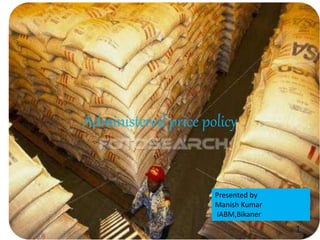Administered price policy
- 1. Administered price policy Presented by Manish Kumar IABM,Bikaner 1
- 2. Flow of presentation âĒ What is price policy âĒ Important factors âĒ What is Procurement âĒ Govtâs Grain procurement âĒ MSP âĒ Objectives of MSP âĒ MIS âĒ References 2
- 3. What is price policy ï A price policy for agricultural produce aims at securing remunerative prices to farmers to encourage them to invest more in agricultural production. ï Keeping this in mind, the government announces minimum support prices for major agricultural products every year. ï These price are fixed after taking into account the recommendations of the Commission for Agricultural costs and prices (CACP) 3
- 4. factors considered by the CACP to regulate price policy âĒ Cost of production âĒ Changes in input prices âĒ Input/output price parity âĒ Trend in market prices âĒ Demand and supply situation âĒ International market price situation âĒ Parity between prices paid and prices received by farmers (Terms of Trade) 4
- 5. What is procurement âĒ Procurement is the acquisition of something of goods and/or services at the best possible total cost of ownership, in the right quality and quantity, at the right time, in the right place and from the right source of the direct benefit or use of corporations, individuals, or even governments. 5
- 6. Govt.âs Grain procurement âĒ The record purchase of over 51 MT achieved last year. âĒ But private interest in procurement of both wheat and rice has been limited , owing to export ban and purchase restrictions imposed by the government. âĒ This passive attitude of the private sector along with an increase in the Minimum support price (MSP), has aided government purchase 6
- 7. ContdâĶ. âĒ It is worth noting that wheat MSP has been raised by 8 percent and the rice purchase price by 20 percent this year. âĒ Wheat procurement has already touched 22.24 MT, marginally lower than the previous yearâs procurement of 22.68 MT. âĒ Similarly, rice purchase has touched 28.45MT, just below last yearâs purchase of 28.5 MT 7
- 8. ContdâĶ âĒ In 2009-10 the central pool had wheat stocks of 29.82 MT and rice stocks of 21.40 MT making for a total of 51.22 MT. âĒ The stocks of both the grains are much higher than the buffer stock norm for the period- 4 MT for wheat and 12.2MT for rice 8
- 9. Procurement of rice and wheat(2006-07to2008-09) 2006-07 35.8 2007-08 37.6 2008-09 55.9 (32.80+22.69) 9
- 10. Minimum Support price of Agriculture commodity âĒ Minimum support price announced by the government is that price at which government is ready to purchase the crop from the farmers directly if crop price becomes lower to MSP. âĒ Govt. has been announcing minimum support price (MSP) for 24 major crops 10
- 11. The main objectives of announcing MSP are: âĒ To prevent fall in prices in the situation of over production. âĒ To protect the interest of farmers by ensuring them a minimum price for their crops in the situation of a price fall in the market 11
- 12. Minimum support and special Drought Relief price for Kharif and Rabi crops in India(20006-07 to 2009-10) Rs. per quintal Crop/Co mmodity 2006-07 2007-08 Increase in MSP 2007- 08 over 2006-07 2008- 09 Increase inMSP200 8-09 over 2007-08 2009- 10 Increase in MSP2009- 10over2008 -09 Kharif crops Paddy 580 645 65 (11.2%) 850 205 (31.8%) 950 100 (11.8%) Jowar 555 620 65 (11.7%) 860 240 (38.7%) 860 0.0 Bajra 540 600 60 (11.1%) 840 240 (40.0%) 840 0.0 Maize 540 620 80 (14.8%) 840 220 (35.5%) 840 0.0 Arhar 1410 1550 140 (9.9%) 2000 450 (29.0%) 2300 300 (15.0%) Cotton 1770 1800 30.(1.7%) 2500 700 (38.9%) 2500 0.0 12
- 13. Contd âĶ. Crop/Commo dity 2007- 08 increase in MSP over 06-07 2008-09 increase in MSP over 07-08 2009-10 increase in MSP over 08-09 Rabi Crops Wheat 1000 250 (33.3%) 1080 80 (8.0%) 1100 20 (2.0%) Barley 650 85 (15.0%) 680 30 (4.6%) _ _ Gram 1600 155 (10.7%) 1730 130 (8.1%) _ _ Masur 1700 155 (10.0%) 1870 170 (10.0%) _ _ Toria 1735 55 (3.3%) 1735 0 (0%) _ _ 13
- 14. Market intervention scheme âĒ The Market intervention scheme (MIS) is an ad-hoc scheme under which are included horticultural commodities and other agricultural commodities which are perishable in nature and which are not covered under the minimum price support scheme âĒ Government implements M.I.S. for a particular commodity on the request of a state Government concerned âĒ Losses suffered are shared on 50:50 basis between Central Government and the State govt. 14
- 15. Commodity-wise Central Government share of Loss under Market Intervention Scheme (MIS) In India (2003-2004 to 2005-2006) Year Commodity State Amount (Rs.in Lakh) * Ginger Mizoram 140.63 Potato West bengal 62.5 Chillies Andhra Pradesh 1242 Potato UttarPradesh 292.52 2003-2004 Orange Rajasthan 19.06 Corrinder seed Rajasthan 45.3 Cumin seed Rajasthan 162.5 Ginger Mizoram 144.15 Onion Rajasthan 21.87 Hatkora Mizoram 14.86 Apples'c' Grade Himachal Pradesh 203.12 2004-2005 Apples'c' Grade Jammu& Kashmir 210.93 Black Pepper Kerala 1010 Chillies Andha Pradesh 1071.21 Garlic Rajasthan 21.87 Onion Rajasthan 19.53 Apple'c' Grade Himachal Pradeesh 663.75 2005-2006 Apple'c' Grade Uttaranchal 53.57 Malta Uttaranchal 50 Hatkora Mizoram 7.2 Chillies Mizoram 15
- 16. Commodity price supports âĒ They are the power and wealth of the state to âSubsidizeâ producer by artificially supporting prices of agricultural commodities reducing the cost of producing them, or in some cases direct cash payments to producers âĒ Commodity price supports are stautory devices designed to enhance the net income of Agricultural producers there laws are called Subsidies 16
- 17. References âĒ Indian Economy -2009 &2010 âĒ www. Ikisan.com âĒ www.Indiastat.com 17
- 18. THANK YOU 18

















